To become truly immortal a work must escape all human limits; logic and common sense will only interfere. But once these barriers are broken, it will enter the regions of childhood visions and dream. – Giorgio de Chirico
The art and poetry of “1 Cent Life” began as a dream by Chinese born artist Walasse Ting (October 13, 1929 – May 17, 2010) – to bring together a community of artists caught between the moment of abstract expressionism and pop-art in the early 1960s.
In 1962, Ting began discussing the publication with his friend, artist Sam Francis. Both men shared strong interests in calligraphy, I-Ching, Henri Matisse and the crossing of East-West culture. Ting wished to combine an array of contemporary artists who worked in many different styles into a single anthology, linking them together with his own art and poetry.
“1 Cent Life” was a landmark publication of 1964, and is now a rare book based on the impressive artwork it contains. It was a revolutionary tract for a collective aesthetic; an assembled vision of Pop and European abstraction, featuring flat hard-edged drawing and splatter painting, biomorphic art, splashing florescent colors and monochromes all meeting up in a single loud and dynamic package. “1 Cent Life” is among the most beautifully conceived and artistic book-works of the 1960s, unlike anything published before or after. It was a compact visual manifesto of the sixties – bright, psychedelic and pulsating, a collaboration of artists who came together under Walasse Ting’s poetic street magic.
With large empty spaces next to areas of maximum color saturation and layered density, “1 Cent Life” was an inspirational book of 1960s design and spirit – a polyglot enterprise –and certainly Ting’s best known work.
Ting’s poems are jarring mystical street-life incantations, sometimes epic and soaring, screamed out in all-capitalized letters or whispered in lower-case. Ting creats a language of dreams and vulgarity, choked off from reality, lacking standard grammar and punctuation, soaked with impulsive wit and exoticism. His pidgin English is the language of a new consciousness – a tongue that is bound with the earth and sky, inflamed and out of sync with technology and the world. His poetics borrow from classical Chinese poetry blended with urban dynamics and jazz riffs, the pathway of an open heart. Ting is a difficult poet but always true to himself; a poet of the street.
WHAT IS SMALL BUSINESS
NOBODY SMALL
YOU LAUNCH STEAMSHIP
I PUSH LOCOMOTIVE
YOU TALK TO MOUNTAINS
I LISTEN TO SEA
YOU EMBRACE RAINBOW
I KISS RAIN
YOU COVER SUN WITH YOUR FINGER
I MOVE MOON IN MY EYES
THOUSAND FLOWERS
BLOSSOM IN OUR BIG HEART
THOUSAND YEARS – Walasse Ting
“1 Cent Life” was dedicated to the maverick Detroit-based contemporary art collector Florence Barron, most famously known as the woman who in 1963, commissioned Andy Warhol to produce his first self-portrait. It’s speculated that Florence Barron put up the funds necessary to print the edition, as one of the main themes of her collection was her love of books and words and their relationship to contemporary art, advertising media and culture. Florence was also very close friends with Ting, an artist she supported and promoted to her friends throughout her life. Several times she brought Ting to Detroit supporting his exhibitions and projects.
This ‘un-livre d’artiste’ is a unique combination of quintessential American Pop Art and European Expressionism with 62 lithographs…..This undertaking is the simple instance in which artists of two essentially contradictory philosophies of art were brought together in one unexpectedly cohesive book. – Riva Castleman
“1 Cent Life” is a large unbound elephant-folio containing 62 original lithographs made by 28 European and American artists with 62 letterpress poems by Walasse Ting and set in multi-colored inks. The 172 page portfolio was written by Walasse Ting and edited by Sam Francis. The lithographs are by; Walaase Ting (6 lithos); Pierre Alechinsky (5 lithos); Karel Appel (5 lithos); Enrico Baj (2 lithos); Alan Davie (2 lithos), Sam Francis (“Pink Venus Kiki” + 5 other lithos); Robert Indiana (2 lithos); Asger Jorn (2 lithos); Roy Lichtenstein (Cover + 1 litho); Joan Mitchell; Claes Oldenburg (3 lithos: “Parade of Women” + “All Kinds of Love 1 & 2”); Mel Ramos (2 lithos), Robert Rauschenberg (2 lithos);Joan Mitchell, Allan Kaprow, Rinehound, Jim Dine, Jean-Paul Riopelle, James Rosenquist; Antonio Saura, Kimber Smith, K.R.H. Sonderberg, Bram Van Velde; Oyvind Fahlstrom, Andy Warhol, and Tom Wesselmann (2 lithos).
The text is in English, and the work is contained in silkscreened cloth boards and dust jacket, housed in a cloth covered slipcase.The lithography was realized and printed in Paris by Maurice Beaudet and the typography carried out in handset letterpress by George Girard. The book was published by E. W. Kornfeld, Bern, Switzerland in 1964, and edited by artist Sam Francis. In addition to the original printing of 1900 unsigned copies, there was a numbered portfolio edition of 100 signed copies in a pink cloth-covered solander box.
The idea was born from global experience, close contact with culture, pseudo-culture, primitive existential worries, urban erotic and eastern wisdom.. It was a Herculean task, for which only a Chinese would have been able to muster the perseverance. – E. W. Kornfeld

Silk screened front cover of the book “rose” by Roy Lichtenstein (right). Back cover “tireur de langue” by Pierre Alechinsky (left).
The chosen title; “1 Cent Life” is ambiguous and unclear. The title could refer to the “one cent life” of poverty that Ting lived in his early career – or as one’s sent life – Ting’s own journey that brought him from the small village of Wuxi to Shanghai, Paris and New York City, the center of the cosmopolitan art world. The title could also be a nod to a larger spiritual or artistic creator, who brought the unity of the collection together. Ting’s ideas and canvas were always in the moment, a reflection of a zen eternity is present in everything.There is no hierarchy or order to “1 Cent Life”, no single artist dominates the book and all pages are loose and removable. The book is steeped in a free-wheeling anarchy -a riotous color scheme seems to be the only rule it follows.
Ting wrote a brief autobiographical poem as an introduction to the silk-screen portfolio Fresh Air School (1972-1973), a collaboration with Joan MItchell, Sam Francis and Ting, published by the Carnegie Institute Museum:
WALASSE TING by WALASSE TING
Born in Shanghai, China, 1929
4 years old paint in sidewalk. 10 years
old draw on wall. 20 years old left
China to traveling after reading the
book of I-Ching. In 1953 arrived in
Paris. Six months later meet Pierre
Alechinsky. Six months later meet
Asger Jorn. Six months later meet
Karel Appel; drink coffee with them
in Paris-Café. Working all kinds of job
to making a very simple living. Living
in a six inches window room. Paint
there, eat there. In 1963 arrived in
New York City. Six months later meet
Sam Francis. Six months later meet
Tom Wesselmann. Six months later
meet Claes Oldenburg. Eat hot & sour
soup with them in Chinese restaurant.
Not working any kinds job. Sleeping
all day living in a sixty feet window
loft. Eat there, paint there. Self-
taught. Individual. Not belong to any
group.
Ting’s respect for the low and neglected, is equally evident throughout the text, where painting, women, sex and food are at the book’s core. There is little concern for monetary consideration in poems where prostitutes, bums, movie stars, the Pope and J.F.K. all share equal billing. When Ting first arrived in Paris from China he lived for many years in a one room apartment on the verge of poverty. While in Paris he met the artist Pierre Alechinsky (who he educated and taught calligraphy yo) later befriending many other members of the color focused expressionist CoBrA group who he’s since become tightly associated with. In the 1970s, Ting’s work developed into a combination of calligraphic styled brush painting and explosive neon color featuring nude women. Ting moved to New York City in 1960 where he moved in circles of both abstract expressionism and pop art.
“one life too short
one day too long” — Walasse Ting
In 2002 Ting suffered a severe brain hemorrhage and was diagnosed clinically brain dead. He lived in a nursing home just outside Amsterdam, the Netherlands. In 2009, his Amsterdam based dealer Nico Delaive gave a press conference and an exhibition titled “Walasse Ting 80th Birthday!” to bring attention to his sad condition. Walasse Ting died in 2010, soon after moving back to New York City. He created a total of 13 books, each one a delightful journey and celebration of life, color and poetry. “So many things to do and no time to die… your blood and my blood make truth,” he wrote in My Shit and My Love, a book of 10 poems and lithographs published in 1961 -the title was taken from a series of five unpublished love poems he wrote for his close friend Nela Arias. In many ways his book My Shit and My Love was an early model for 1 Cent Life. It was a shorter but similar tall portfolio with the same tangled mass of color and design, printed by the same superb French lithographers for 1 Cent Life, matched up with Ting’s raw street poetry.
According to Delieve, “he couldn’t paint colour without sex. Before sex he paints with black and white; after sex, it’s like his life has been lit up. And food, I have never seen anyone enjoy great food as much as he did. And now the nurse has to push food into his mouth, and the woman he had loved and lived with for 18 years is not allowed to be there with him. I can’t imagine he would like to live in this way… Walasse Ting is alive! But the way he lives is simply inhuman!” ( quoted source: Gallery Delaive)
“Please look this book on toilet, If you like
buy me cup of coffee next time you see me…”
–Walasse Ting, copyright page from “Red Mouth”

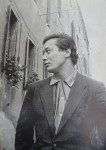
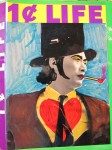
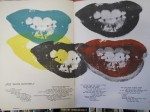
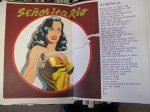
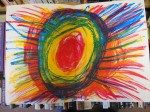
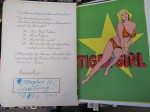
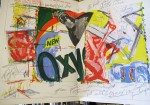
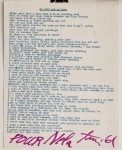
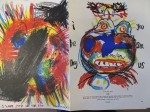
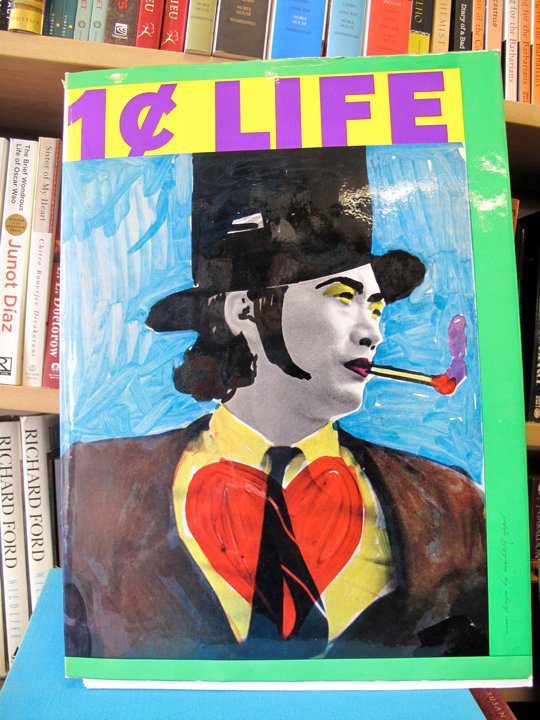
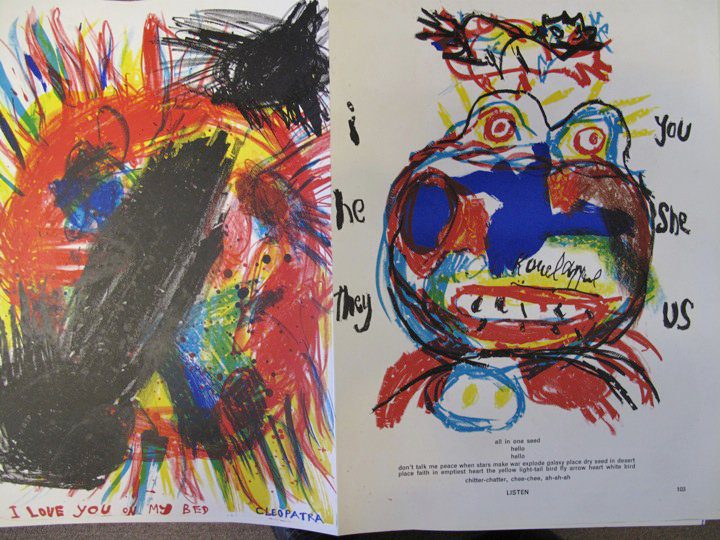
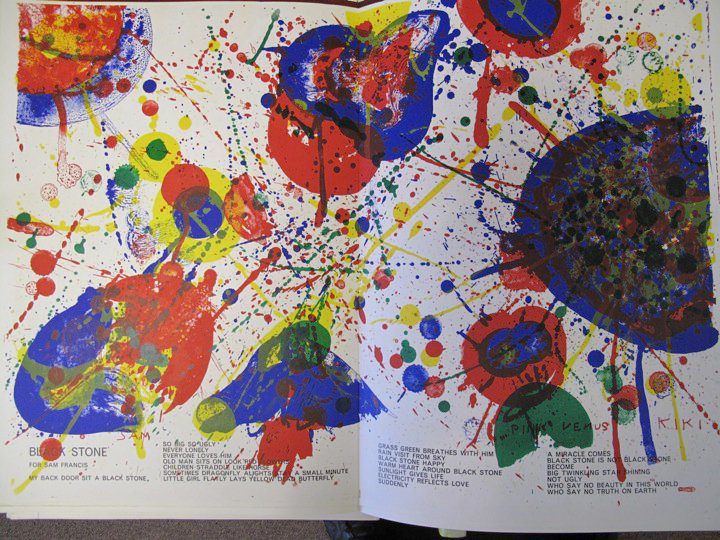
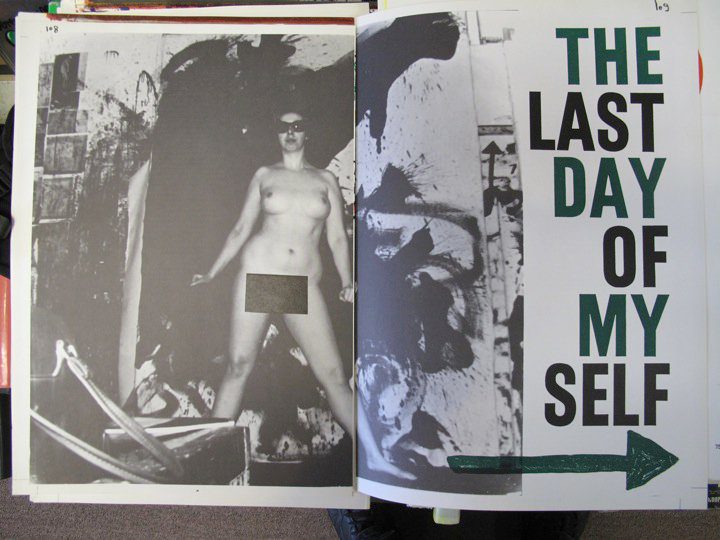
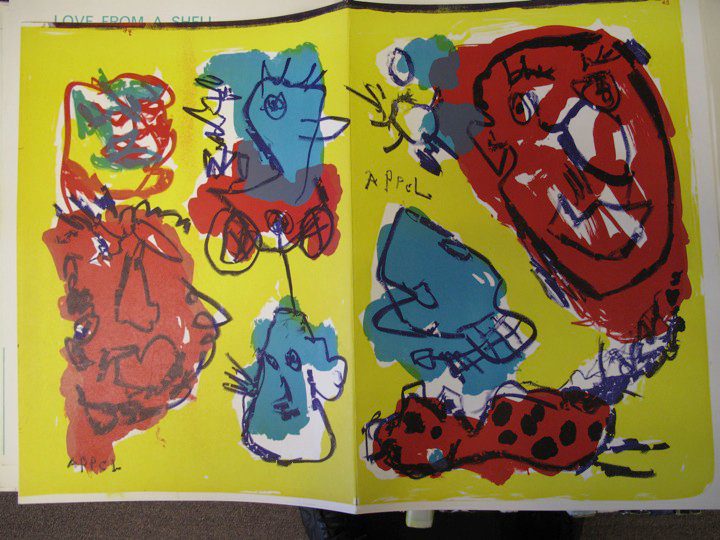
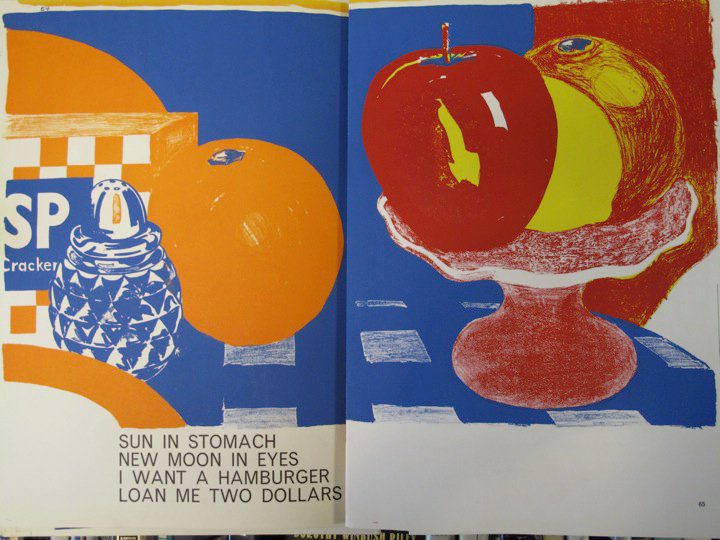
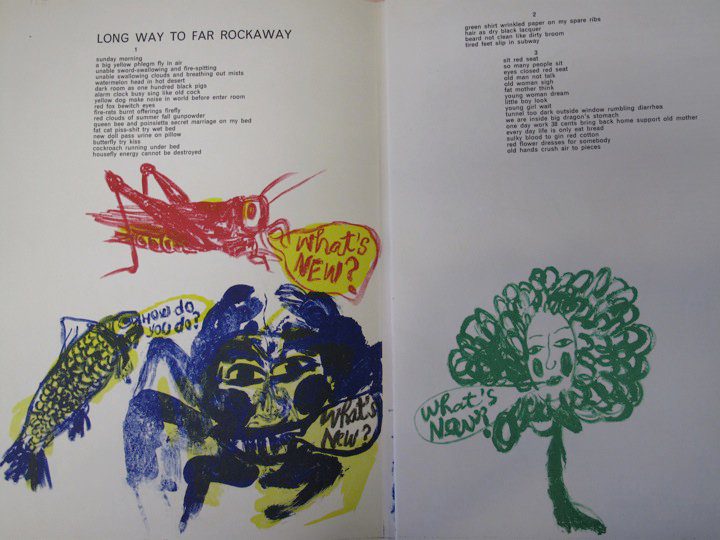
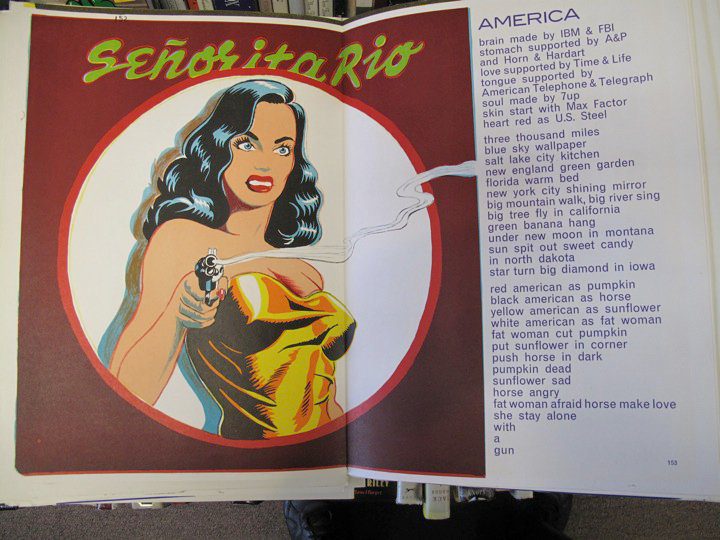
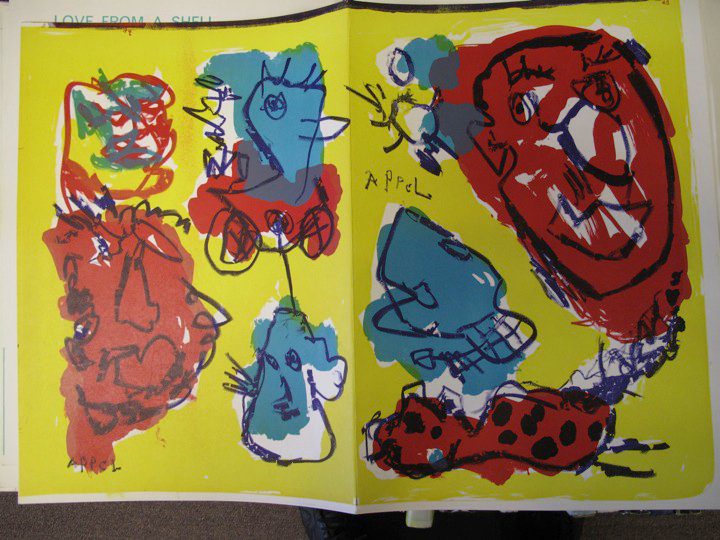
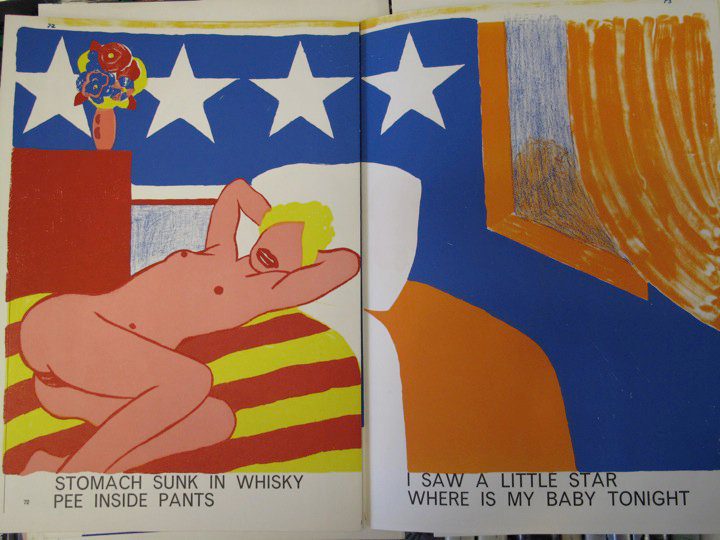
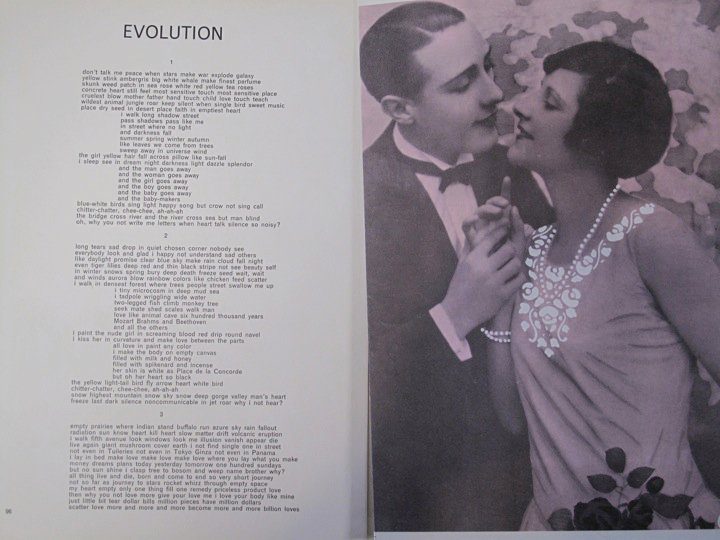
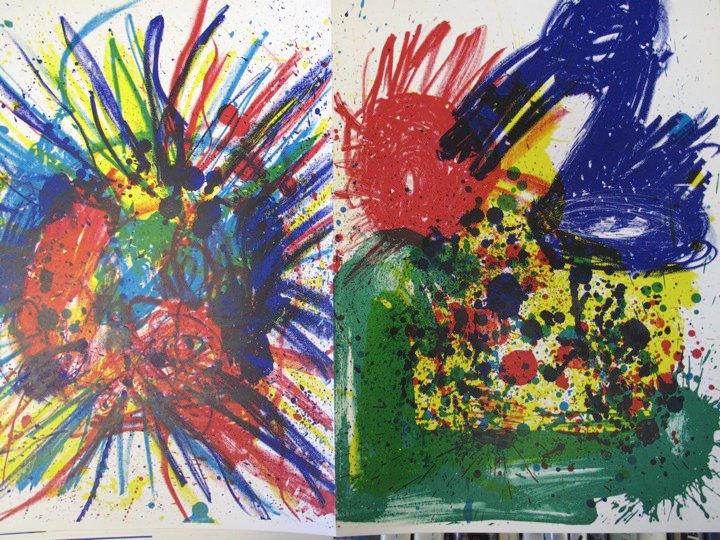
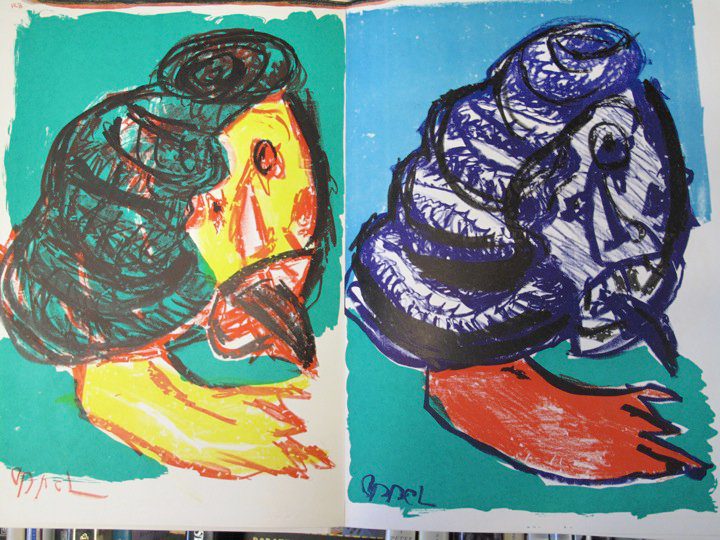
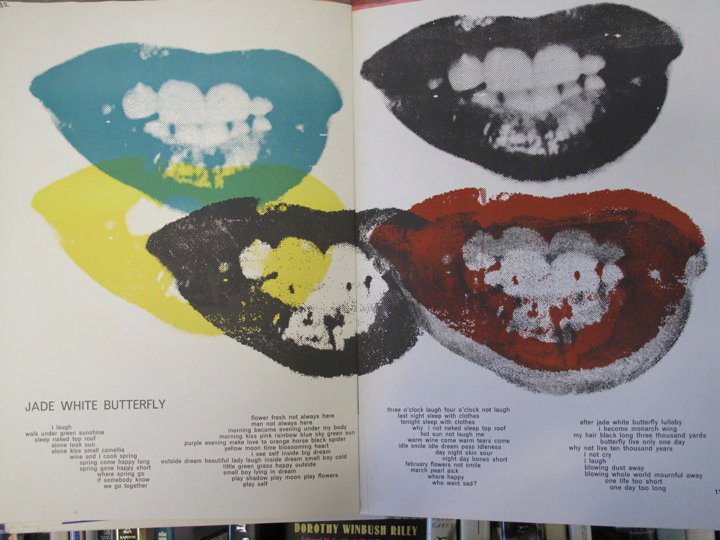
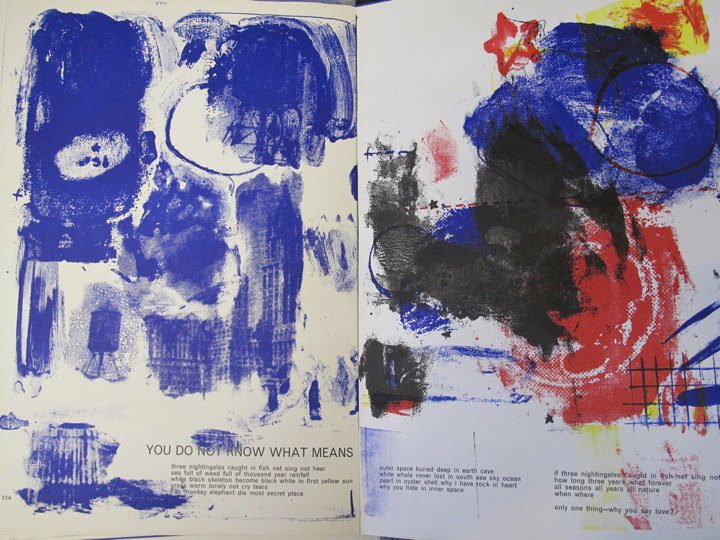
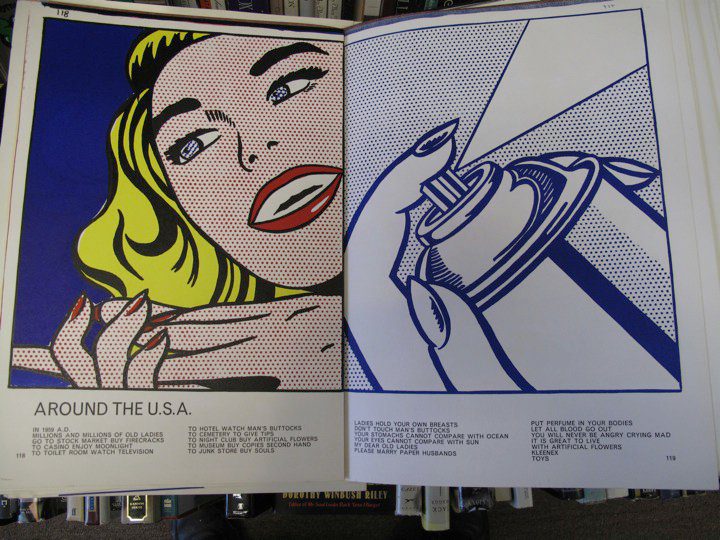
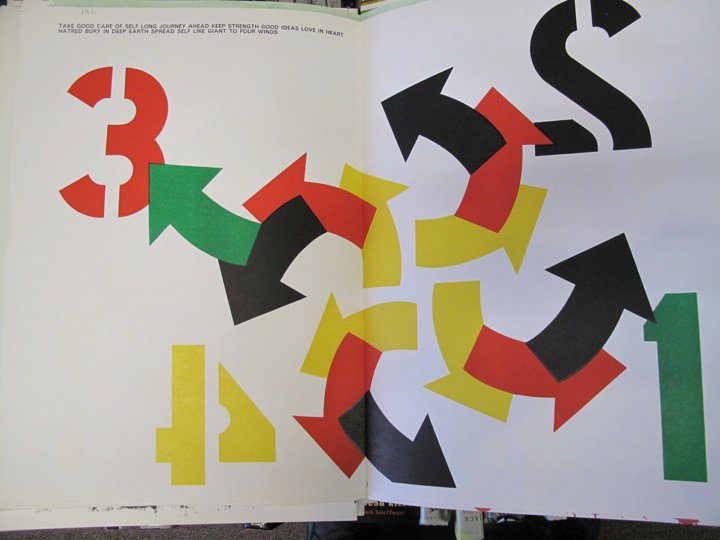
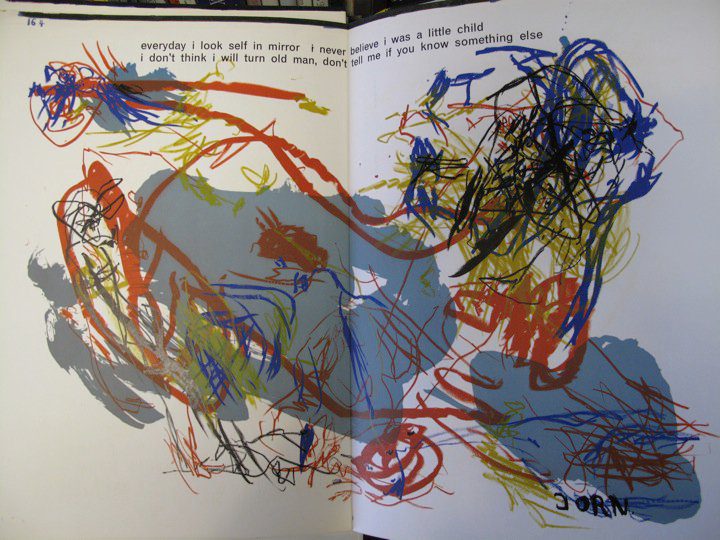
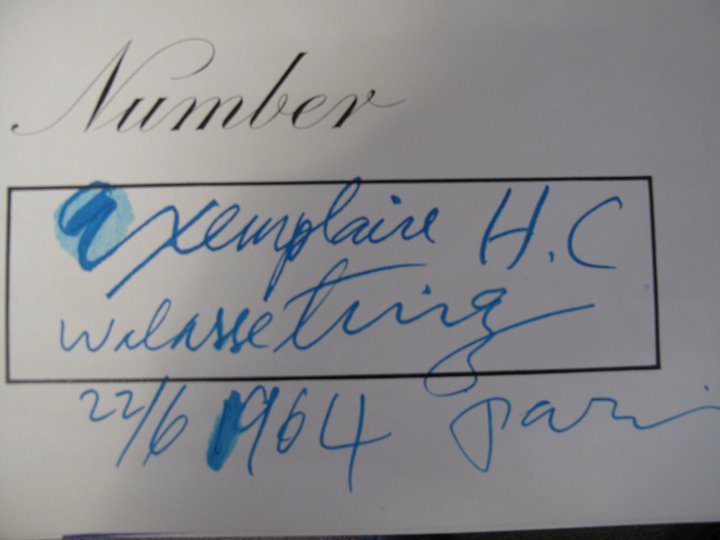
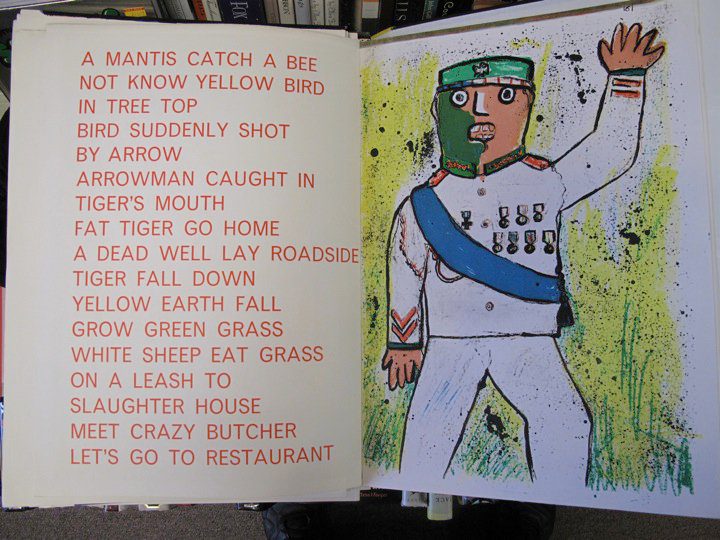
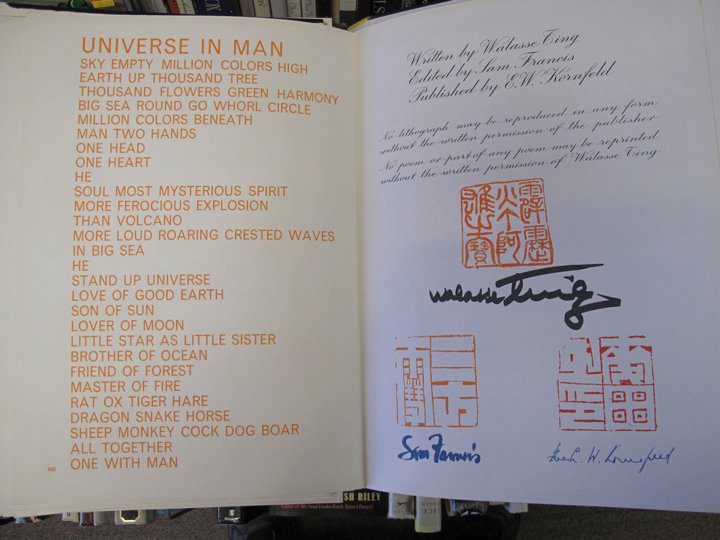
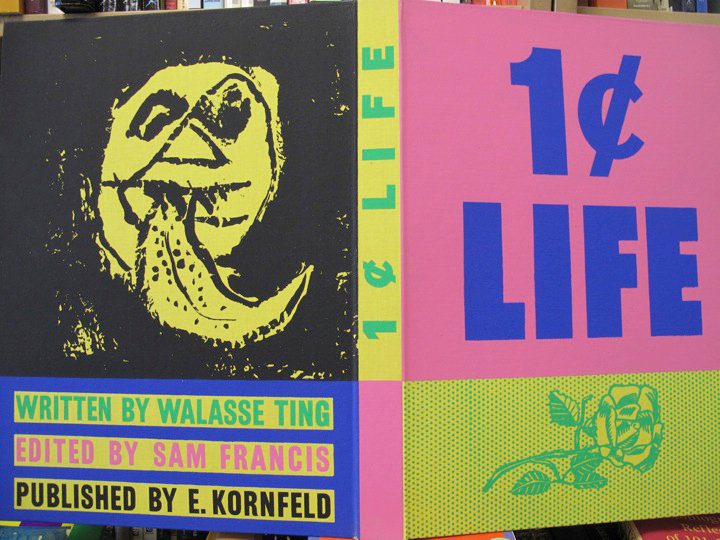
Is there a place to purchase a reproduction of “1 cent Life”?
Sadly no, the title is long out-of-print.
An original of the 2000 limited editions can be found online from between $6000 and $8000. Unfortunately, unscrupulous art dealers have dismembered hundreds of the original portfolios and many individual lithographs from the portfolio can be found for sale online. Many of the better art museum and university libraries have this in their permanent collections and access by the public varies.
That’s very sad to hear -so many great books are butchered for their prints. I know the Detroit Institute of Arts has a copy in their collection, and saw it recently on display.
I have copy #545 of 2000. I have enjoyed this eclectic collection of beautiful lithos and Wallase Tings incredible poetry for many, many years. I will consider selling, as I have no one to leave it to that would appreciate it’s beauty. It is complete, with hard cover and dust jacket. I don’t want it dissected, and sold as individual prints. I will check back for posts of interest.
i was asked to try and sell a copy for a friend..she has a copy in perfect condition with all prints…her father worked for the printers in bern…..if anyone is interested reply to marc bross houseoftea@hotmail.com
James D
I am very interested in your book. My daughter is an art student and I would love to gift her this book.
Let me know if is still available.
USA
Cornell,
Leave me your email address.
Is there another way you prefer to be contacted re: the book?
sorry for late reply…
Pls email me at
justaname@email.com
Thx
James
Sorry for the late reply
Contact me at
justaname@email.com
Thx
If anyone is still interested in the book it is for sale on a danish auction right now. It ends at august 4th, so one has to be quick.
I have seen the book myself and it is in perfect condition.
The auction is on http://www.bruun-rasmussen.dk – search for 1 cent if the link below doesn’t work.
http://www.bruun-rasmussen.dk/search.do?pg=1&iid=300765157&mode=detail
If anyone still,has a copy for sale, let me know! Wwmx@telenet.be
This book is currently on auction in Denmark
http://www.lauritz.com/Item/Item.aspx?ItemId=4119031&LanguageId=1
I know he had a box full of 1ct life sent back to WuXing And I am sure back there for in the family coffer they would have sat there waiting for someone to crab them.maybe next time I go back I can investigate
This has become the unofficial 1 cent exchange. Thank you for stopping by.
Hello, i’m Looking for a complete edition (preferabele edition 100) of 1 cent life. Please e-mail wwmx@telenet.be When you have a lead! Thx!!!
I have a copy of this for the collection of Andy Warhol collection bought at his estate sale at Sotheby’s signed by all the artists in the book, Mint condition and comes with an Ex Libris from Warhol’s library and a Sotheby’s sticker plus iit’sin the Sotheby’s catalog. I can send pictures. Anybody interested? I am selling this for a private collector, I am an art dealer in Manhatten New York.
Thank you, Pablo at Kunst Editions New York
Dear Pablo,
I am a private Collector in Germany near Frankfurt. Is your work in good condition and complete? If it is I am interested to buy if the price is fair.
I just saw this at the Bechtler in Charlotte – my life has changed forever.
Same
It’s always great to hear a book has changed a life forever.
Hello Cary –
Thank you for this interesting and informative article. I learned a lot from it. However, I am somewhat irked by the use of terms like ‘dismembered’ and ‘butchered’ to describe the practice of selling off individual prints. I guess this might not be a popular point of view in this forum, but please allow me to present a dissenting opinion.
I am a print collector and dealer – my art dealing arose in large part out of the desire to fund my own collecting. I have at various times bought prints from 1c Life, specifically those by Alan Davie, Antonio Saura, Enrico Baj, Karel Appel and Claes Oldenberg. Some of these I intend to sell on, but most will remain in my personal collection, where they give great pleasure to both myself and visitors to my home, since they are framed and displayed.
I have never owned an intact copy of 1c Life, nor am I ever likely to, given your quoted market value of $6000-8000 (the last copy I saw offered for sale was £5250, which would put it at the upper end of this range). That kind of price is completely out of reach for a collector of my modest means. I would guess that around half of the value of an intact copy is due to the presence of the Warhol and Lichtenstein prints, which are of limited interest to me – I am far more interested in the European COBRA artists and the more expressionist American artists such as Joan Mitchell, Sam Francis and indeed Ting himself. So if I see a 1c Life print by say, Saura or Appel being offered at less than £100 (as in fact I did), why shouldn’t I buy it and enjoy it? Who or what suffers as a result?
Consider the following: it is debatable whether 1c Life is in fact a book or a portfolio, since as noted in your article, it was presented as a loose-leaf collection in a binder. This would suggest that Ting anticipated and approved of individual prints being removed from the collection. Furthermore, I would argue that it is entirely in keeping with Ting’s freewheeling, anarchic, egalitarian style and artistic vision that the beautiful artworks presented in 1c Life should be dispersed and enjoyed as widely as possible. If you believe (as would seem to be the case) that this publication should only be available to museums and a few well-heeled bibliophiles, do you think that Walasse Ting would agree with you, or might he find that a little elitist?
Hi Simon,
I’m sorry for the delay in responding.
You make an interesting point and I’m not sure what Ting would think about the trade in these prints. I believe since he was an artist that did prints in both ‘books as art objects’ and editions of prints outside the books, Ting would probably like to see the preservation of his art book. Allowing print editions to be traded as prints — and letting books be books.
The destruction of books for prints is what causes a book’s rarity and increasing value. The print market is outside my area, but I would say the harm it causes is two-fold: first it defaces the book (making what’s left of it a lesser work of art and value). Secondly, it increases and inflates the value of what volumes are left intact, causing a cycle of scarcity and the desire to ruin and tear apart more books.
I find booksellers who participate in this trade to print dealers part of the guilty party. Unfortunately we live in a market driven economy and most sellers of rarities will sell out self-preservation.
I’m thankful there are museums and special libraries where this type of book can exist to be displayed, studied, and enjoyed by the public. The facsimile edition of an artist book (like Matisses’s Jazz) also has an important function in bringing rare books to the public.
Thank you kindly for your comments and point of view.
Alan Davie print the only thing I know is it says inside front cover. I bought it in the sixties and would like to know more about it. It’s value etc Has poetry on back
I’m sorry but we’d need to see the book in person to make an evaluation, thank you.
i would be interested in purchasing if you have a complete one and could provide pictures. my email is treed238@gmail.com I look forward to seeing yours (chandler) or anyone else’s. beginner collector here that has always been fascinated with this portfolio.
thanks,
tyler
I’m looking for a copy to add to my art book collection.
Hello Richard, I would contact some of the commenters on this post who have mentioned they may have copies for sale. Good luck!
Hi Richard (and others) – I have a copy for sale that is signed by Ting and Francis. Feel free to email me at: nmpajerski@gmail.com to discuss a price.
Hello – Can you tell me where the copy number would be located? I own a copy and cannot find a number in any place obvious.
Thanks
Hi Paul, check the colophon in the back of the book– (there is one pictured in the gallery above in the body of the article) –since pages are loose, you might be missing one. Try to compare your copy to one online or in a collection.
Dear Cary,
I am in charge of Nela Arias-Misson’s archives, and it contains several personal letters and poems by Walasse Ting that start in 1959, when he arrived in New York. They are all postmarked from his Studio on 25 Street. The poems include ‘My Shit and My Love dedicated to her’ and “My dear white skeleton”, another of the poems in 1cent life. Other poems in her archives are : ‘Around the USA’, ‘The little white flower in my heart’, ‘The best of everything’ and ‘Blood after tears’, and one page which contains two poems: ‘Four Great Vacuums’ and ‘Cry on the rock’ and I could not find the last six poems anywhere. Perhaps you know if they have been published.
Of course, I am interested in finding a copy of 1 cent life, since Nela was also friends with Karel Appel, and Saura. Would you be able to help me?
Oops, ‘Around the USA’ is dedicated ‘Pour Nela’ and signed September 23, 1959, Walasse Ting.
I just realized that his one was illustrated by Lichtenstein.
Flor
Many years ago I was able to purchase one complete example at an auction in Switzerland.
If you are interested please contact me at: ma@acosta.ch